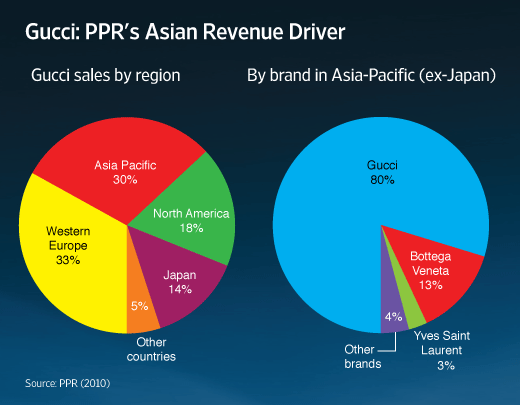HONG KONG (Dow Jones Investment Banker) – PPR SA’s refocusing is still a work in progress. The lack of growth at its legacy retailing business is affecting overall margins, and penalizing valuation. A flotation of part of the Asia-Pacific activities of its luxury arm, Gucci Group, in Hong Kong would boost its market capitalization, and create a vehicle to fund acquisitions in its fastest-growing region of operations.
Disposals of PPR’s Printemps department stores in 2006, part of its African distribution network, CFAO SA (via a 2009 IPO), and furniture retailer Conforama in 2010, have enabled the group to concentrate on two segments, sports and lifestyle, and luxury goods.
Yet, the margins at PPR (market cap US$17 billion) remain lower than those of its competitors, as lackluster growth at its remaining retail operations, especially FNAC, its electronics, books and music chain, continue to take their toll. PPR’s share price is down more than 10% this year, and with a 2012 consensus P/E of only 11x, the valuation lags comparables that offer a more attractive, pure play proposition.
Gucci Group accounted for 27% of PPR’s revenue in 2010, or about US$5.4 billion, and was the only segment that grew over the period. That proportion jumped to 31% in the first half of 2011, when Gucci Group’s growth across all of its brands contributed 84% of PPR’s overall sales growth. It’s also the main engine for PPR’s profits, accounting for 57% of recurring operating income last year.
In 2010, the Asia-Pacific region ex-Japan generated 11% of PPR’s overall revenue. That’s less than half what competitor LVMH Moët Hennessy Louis Vuitton SA’s Asian operations contributed to LVMH’s top line, but sales grew by more than 30% over the period.

Gucci Group’s global brand portfolio includes – among others – Yves Saint Laurent, Alexander McQueen, Stella McCartney and jeweler Boucheron, but Gucci and Bottega Veneta account for the lion’s share of revenue, both globally and in Asia. The other brands are, at this stage, more dependent on sales in Western Europe and North America, and also well behind in terms of profitability.
PPR discloses that the Asia-Pacific region accounts for 30% of Gucci Group’s turnover – just over US$1.6 billion. Gucci Group operates some 227 own outlets there, including over 50 Gucci stores and 23 Bottega Veneta stores in mainland China.
Floating part of Gucci Group’s Asia-Pacific operations in Hong Kong would provide a vehicle to fully recognize what is the main source of growth for PPR. As we have argued with respect to LVMH’s regional activities, the arbitrage in valuation is also too tempting to ignore.
(Click HERE for my column of 19 September 2011 “Memo to Bernard Arnault”)
Because of its smaller size – and a drop in the ocean among the more than US$100 billion in global spinoffs this year to date – Gucci Group Asia may not perhaps achieve Prada SpA’s forward P/E multiple of more than 27 times. But that multiple represents more than twice the level at which PPR is currently trading, clearly enough to allow for a significant improvement in value.
Assuming forward sales of, say, US$2 billion, a net margin of 10% and a P/E of 22 times, Gucci Group Asia could list through an IPO of more than US$1 billion, assuming the usual 25% float. With Gucci Group at an earlier stage of development in Asia than some its European competitors, good upside can be expected.
It’s been argued by some that Prada’s high valuation is the result of low trading levels. But with a 30-day average daily volume of almost US$24 million (and of US$34 million as calculated over 90 days), the stock can hardly be said to be illiquid. North American institutions generated the largest orders in Prada’s IPO and still account for a disproportionate share of its register. A truly global marketing exercise and some Asian anchor institutions as shareholders would define Gucci Group Asia as a local play. It would not, however, suffer from the Italian withholding tax issues that contributed to a poor showing on the part of retail investors in Prada’s public offer – which ultimately had to be cut in size.
Now is clearly a challenging time to bring companies to market. But with the new issue window likely to re-open sooner in Asia than in Europe, or indeed in the U.S., Chairman and CEO François-Henri Pinault may perhaps want to initiate work on that PR pitch for Hong Kong investors.
(Philippe Espinasse worked as an investment banker in the U.S., Europe and Asia for more than 19 years and now writes and works as an independent consultant in Hong Kong. Visit his website at https://www.ipo-book.com. Readers should be aware that Philippe may own securities related to companies he writes about, may act as a consultant to companies he mentions and may know individuals cited in his articles. To comment on this column, please email [email protected]).
[This article was originally published on Dow Jones Investment Banker on 26 September 2011 and is reproduced with permission.]
Copyright (c) 2011, Dow Jones & Company, Inc.
